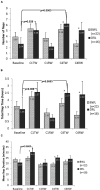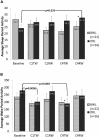Preventing Sleep Disruption With Bright Light Therapy During Chemotherapy for Breast Cancer: A Phase II Randomized Controlled Trial
- PMID: 35356054
- PMCID: PMC8959343
- DOI: 10.3389/fnins.2022.815872
Preventing Sleep Disruption With Bright Light Therapy During Chemotherapy for Breast Cancer: A Phase II Randomized Controlled Trial
Erratum in
-
Corrigendum: Preventing sleep disruption with bright light therapy during chemotherapy for breast cancer: a phase II randomized controlled trial.Front Neurosci. 2024 Oct 3;18:1386314. doi: 10.3389/fnins.2024.1386314. eCollection 2024. Front Neurosci. 2024. PMID: 39420984 Free PMC article.
Abstract
Purpose: The goal of this study was to examine whether daily increased morning light exposure would maintain or improve sleep and the circadian pattern of relatively more activity in the day and less during the night in women undergoing chemotherapy for breast cancer.
Patients and methods: Participants were 39 women with newly diagnosed breast cancer, randomized to either 30-mins of daily morning bright white light (BWL) or dim red light (DRL). Sleep/wake was measured objectively for 72-h with wrist actigraphy and subjectively with the Pittsburgh Sleep Quality Index (PSQI) prior to and during chemotherapy cycles 1 and 4. The study was registered with the National Institutes of Health ClinicalTrials.gov (Clinical Trials number: NCT00478257).
Results: Results from actigraphy suggested that compared to the DRL group, women in the BWL group had longer night-time sleep, fewer sleep disturbances during the night, and had fewer and shorter daytime naps at the end of cycle 4 of chemotherapy as well as exhibiting less activity at night and more activity during the day by the end of cycle 4. Results from PSQI indicated that components of sleep quality improved but daytime dysfunction deteriorated during cycle 4 treatment in the BWL group; meanwhile the DRL group used more sleep medications in the treatment weeks which might have led to the improved sleep quality during the recovery weeks of both cycles.
Conclusion: These results suggest that bright white light therapy administered every morning on awakening may protect women undergoing chemotherapy for breast cancer from nighttime sleep and daytime wake disruption. Randomized clinical trials in larger samples are needed to confirm these findings.
Keywords: PSQI; actigraphy; activity; breast cancer; light therapy; sleep.
Copyright © 2022 Rissling, Liu, Youngstedt, Trofimenko, Natarajan, Neikrug, Jeste, Parker and Ancoli-Israel.
Conflict of interest statement
SA-I was a consultant for Eisai, Biogen, Merck, Idorsia, and Pear Therapeutics. NJ was a student at UCSD at the time of the study and currently works for J&J which has had no influence or funding of this study. The remaining authors declare that the research was conducted in the absence of any commercial or financial relationships that could be construed as a potential conflict of interest.
Figures





Similar articles
-
Light treatment prevents fatigue in women undergoing chemotherapy for breast cancer.Support Care Cancer. 2012 Jun;20(6):1211-9. doi: 10.1007/s00520-011-1203-z. Epub 2011 Jun 11. Support Care Cancer. 2012. PMID: 21660669 Free PMC article. Clinical Trial.
-
Bright light therapy protects women from circadian rhythm desynchronization during chemotherapy for breast cancer.Behav Sleep Med. 2012;10(3):202-16. doi: 10.1080/15402002.2011.634940. Behav Sleep Med. 2012. PMID: 22742438 Clinical Trial.
-
Novel Augmentation Strategies in Major Depression.Dan Med J. 2017 Apr;64(4):B5338. Dan Med J. 2017. PMID: 28385173 Review.
-
The Effect of Systematic Light Exposure on Sleep in a Mixed Group of Fatigued Cancer Survivors.J Clin Sleep Med. 2018 Jan 15;14(1):31-39. doi: 10.5664/jcsm.6874. J Clin Sleep Med. 2018. PMID: 29198295 Free PMC article. Clinical Trial.
-
[Sleep disorders in patients with a neurocognitive disorder].Encephale. 2022 Jun;48(3):325-334. doi: 10.1016/j.encep.2021.08.014. Epub 2021 Dec 14. Encephale. 2022. PMID: 34916075 Review. French.
Cited by
-
The effect of light therapy on sleep quality in cancer patients: a systematic review and meta-analysis of randomized controlled trials.Front Psychiatry. 2023 Jul 10;14:1211561. doi: 10.3389/fpsyt.2023.1211561. eCollection 2023. Front Psychiatry. 2023. PMID: 37492065 Free PMC article. Review.
-
Effects of chronotype-tailored bright light intervention on post-treatment symptoms and quality of life in breast cancer survivors.Support Care Cancer. 2023 Nov 17;31(12):705. doi: 10.1007/s00520-023-08157-9. Support Care Cancer. 2023. PMID: 37975923 Clinical Trial.
-
Learning from circadian rhythm to transform cancer prevention, prognosis, and survivorship care.Trends Cancer. 2024 Mar;10(3):196-207. doi: 10.1016/j.trecan.2023.11.002. Epub 2023 Nov 23. Trends Cancer. 2024. PMID: 38001006 Free PMC article. Review.
-
Circadian, hormonal, and sleep rhythms: effects on cancer progression implications for treatment.Front Oncol. 2023 Sep 7;13:1269378. doi: 10.3389/fonc.2023.1269378. eCollection 2023. Front Oncol. 2023. PMID: 37746277 Free PMC article. Review.
-
Interventions for insomnia in cancer patients and survivors-a comprehensive systematic review and meta-analysis.JNCI Cancer Spectr. 2024 Apr 30;8(3):pkae041. doi: 10.1093/jncics/pkae041. JNCI Cancer Spectr. 2024. PMID: 38781520 Free PMC article.
References
-
- Ancoli-Israel S., Liu L., Natarajan L., Rissling M., Neikrug A. B., Youngstedt S. D., et al. (2021). Reductions in sleep quality and circadian activity rhythmicity predict longitudinal changes in objective and subjective cognitive functioning in women treated for breast cancer. Support. Care Cancer 2021:3. 10.1007/s00520-021-06743-3 - DOI - PMC - PubMed
-
- Ancoli-Israel S., Liu L., Rissling M., Natarajan L., Neikrug A. B., Palmer B. W., et al. (2014). Sleep, fatigue, depression, and circadian activity rhythms in women with breast cancer before and after treatment: a 1-year longitudinal study. Support. Care Cancer 22 2535–2545. 10.1007/s00520-014-2204-5 - DOI - PMC - PubMed

